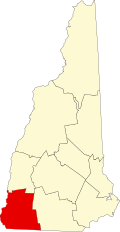Corban C. Farwell Homestead | |
 | |
| Location | Breed Rd., Harrisville, New Hampshire |
|---|---|
| Coordinates | 42°56′34″N72°8′3″W / 42.94278°N 72.13417°W |
| Area | 0.5 acres (0.20 ha) |
| Built | 1901 |
| MPS | Harrisville MRA |
| NRHP reference No. | 86003253 [1] |
| Added to NRHP | January 14, 1988 |
The Corban C. Farwell Homestead is a historic house at the junction of Breed and Cricket Hill roads in Harrisville, New Hampshire, United States. Built in 1901 by a local farmer, it is an architecturally eclectic mix of Greek Revival, Colonial Revival and Queen Anne styling. It was listed on the National Register of Historic Places in 1988. [1]


